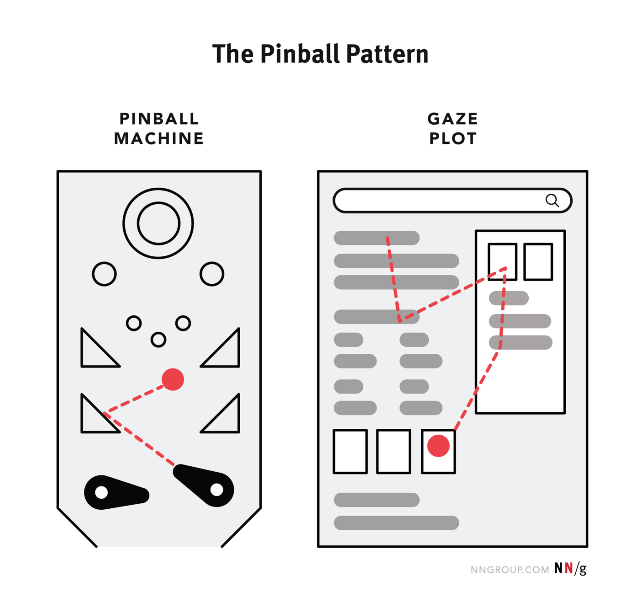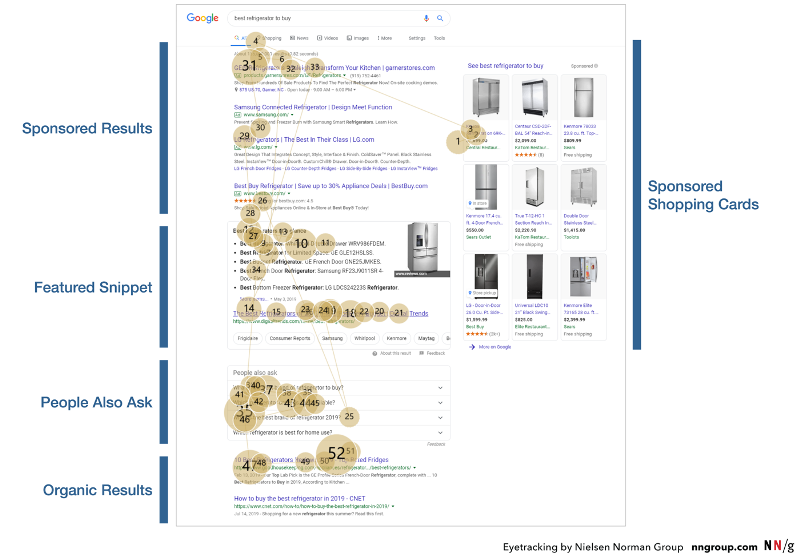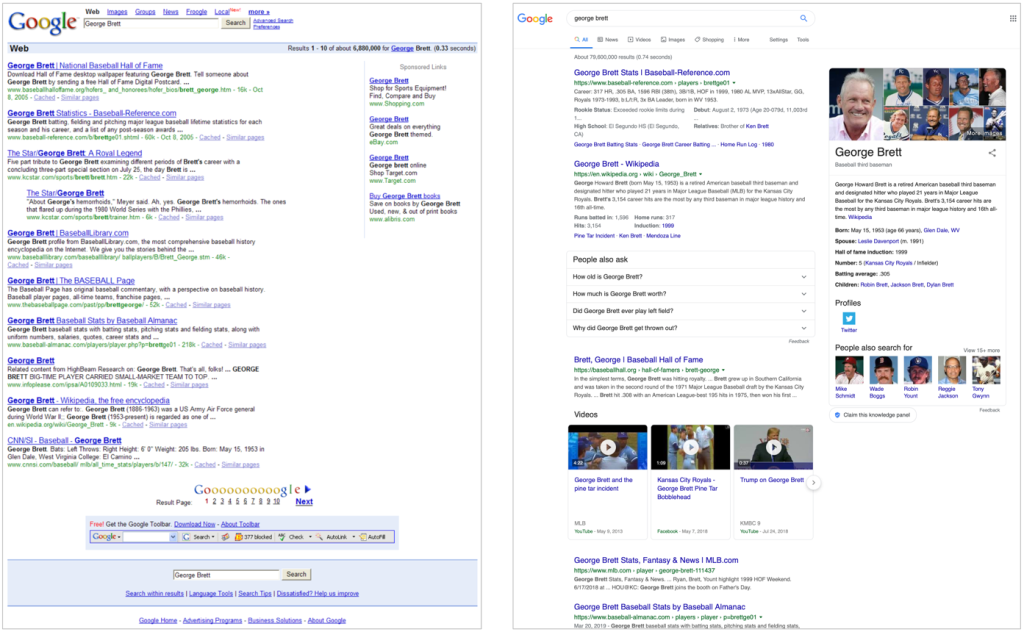Google SERPs and features, to understand users is pivotal to SEO
In the last few weeks we often talked about how Google is changing the page appearance of search results and, according to Rand Fishkin, even its business goals, imposing itself as competitor of all web sites. We know that every feature implemented over the years is currently impacting on users – summing it up, zero-click researches are increasing and the user journey automatically ends on the SERP – and consequently nowadays an effective SEO strategy must take into account these trends.
SERPs intricacy changes search behaviour
In the United States, a study by Nielsen Norman Group provides us a proper picture of the situation, analyzing the impact of all features brought into search engine pages, like knowledge panel, images, Google My Business tabs and local packs, featured snippets or more generically all multimedial results generated by queries. Results are based on the analysis of 471 queries made by attendees within ocular tracking studies and usability tests carried out between 2017 and 2019.
According to the research, users directly look at rich results in the 74% of cases, proving how the visual weight of Google SERP features is impacting even the actual path of the user’s sight. Moreover, given the fact that the number of features can vary from query to query, the study also tells us that the gaze pattern is not straightforward, and for that also the strategies made to stand out must be flexible.
The influence of images and features on people’s gaze
Kate Moran, author of the analysis and Nielsen Norman’s senior user experience specialist, released some comments to the Search Engine Journal highlighting the main aspects found by the investigation. First of all, it is confirmed the value of images for the SEO, because these resources “definitely drew attention: they are visually attractive and also helped users quickly check that the results were about the topic they were looking for”.
But users also appreciate other elements that are able to give quick answers, like featured snippets, knowledge panels or People also asked, that always lure people’s attention when appearing on SERP.
Users evolve and quickly interact with SERPs
It is very interesting to notice the increasing complexity and all the variations inside search result pages do not seem to prevent users to act in a relatively fast way: the study participants took on average only 5.7 seconds to click on their first selection. This means that our habits evolve and adapt to changes, but also that we learned to interact with SERPs.
This is also highlighted by a different Yext analysis focused on the actions of the consumers on local business results (click to obtain road indications, click to call companies) on the search engine, that about last year reports that their increase has a wider margin (17%) compared to business results’ impressions (10%).
Numbers that suggest consumers are able to find what they want quicker: whether are the users learning to use more specific queries or search engines better in understanding those queries, the fact is that people devote less time to the search and more to directly interact with companies, concludes the Yext study.
A new method to guide people’s gaze
Broadening the consideration, these analysis question the old interpretation of SERPs (and its importance to SEO): the value of the first place in a SERP is based on the idea that users browse lists in order. But the modern search result page can include different types of results, advertisements and interactive elements, alongside the traditional blue links, and users move their gaze among these elements in an irregular way.
Pinball pattern, attention distributed on SERP
Consequently, the attention is distributed all over the page and the results viewed in an irregular way or less regular than before, at least. The Nielsen Norman Group called this phenomenon the pinball pattern: right like the classic game, people’s gaze move fast among the elements of the page apparently without a logical criteria, even because SERPs vary from query to query and so it needs to often evaluate the page before diving in too deep and make a selection among offered sites.
Google’s features lead users
Each specific query may present multiple research features, going from rich answers to carousels and everything else: this info selection has a core role in guiding user’s attention on the page. And so, the report suggests, “the layout of a SERP can determine which links get visibility and clicks” and “the position of visually compelling elements often affect the visibility of the organic results near them”.
The image above (taken straight from the study, like all others on this page) shows the gaze path of a participant searching for “the best fridge to buy“. First, the person aimed his attention towards the sponsored shopping results on the right, then on the featured snippet and the “people also ask” box prior to actually look at the first organic result.
How organic placements’ CTR changes
The evolution of people’s search behaviour is particularly obvious in Google placements‘ CTR: in 2006, the site in first place used to gain the 51% of all clicks, while currently the first link (meaning the first elements under the search box and for that also the ADS) gains about the 28% of them.
The study confirms the actual weight of the Top3 placements on Google, that alone get more than half (59%) clicks, but bottom placements are getting a slightly higher click percentage compared to 2006. There were also noticed some cases in which users kept on navigating in the search result page while waiting for the loading of a clicked result; some people got back to search results to look for a second displayed element to select if their former selection did not solve the research (classic example of Pogo Sticking, the rebound between SERPs and unsatisfactory ranked results).
What really matters, we can say with fair confidence by now, is not the organic placement in the SERP, but the visual one: only 5% of query selections with navigational or informative search intent to check on facts ended on below the fold sections; for more complex search activities, this rate goes up to 20%. This suggests us that sites currently publishing insightful contents could still be able to captivate clicks even if they are placed lower within the SERP, but it should be reminded that users actually went beyond the first result page only for the 2% of all queries.
What does this mean for SEO?
As we already said between the lines, this study represents an accurate analysis of how people navigate through search results nowadays, providing us cues to optimize search feature; as George Nguyen remarks on SEL, the first organic placement is today just one of many factors that can bring visibility to a site on Google.
The standard blue links have lost their value (in the United States they use the expression “SERP real estate”) compared to Ads and rich answers, the actions of the clients on Google My Business tabs are increasing, but most of all the major part of Google researches now end without a click on other contents, meaning that there is less organic traffic available to editors.
Anyway, succeeding in getting into the top5 Google results gives you fair chances to lure a precious glance from an user. More in general, it still is fundamental to appear inside the first page of results, given the fact that is highly probable that people would never click on the second.
In practical terms, whoever works online and is trying to get visibility on Google must plan his strategies starting from these trends and trying to understand the habits of his target: as the previously mentioned Rand Fishkin says, we need to invest on the on-SERP SEO, optimize contents on the perspective of the features that make more sense to our business and find out the best way to reach the audience through search results.







